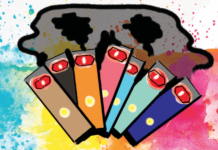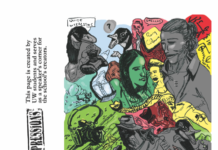Challenge: Gender equality. Students stop at an interactive display, engaged by a list of provisions to fight global gender imbalances. Below the board, a picture of an 11-year-old Colombian girl reading a textbook emphasizes the work of many educational programs for young women in developing countries.</p>
Gender inequality is one of many topics patrons learned about along a 1,000-square-foot exhibition space titled Together: An exhibition on global development. The Aga Khan Foundation, a registered charity and agency developed the exhibit, a custom-built tour bus. Displaying the work of 21 organizations, Together focuses on increasing general knowledge about global change.
The exhibit took place in Waterloo Oct. 21-22, hosted by Conrad Grebel University College. Presently, the mobile exhibit is finishing up its tour of Ontario.
Stephanie Laroque, the tour manager, believes attracting students to volunteer for these causes is important: “We want to inspire [students] to take action and get involved.” Students’ developing role in reducing global poverty is a key motive for marketing to the younger generation. Laroque said that they host many activities at educational institutions to grab students’ attention: “We want to make [them] more concerned about global development.”
Challenge: Food security and nutrition. Students stop and learn about steps Canada can take in protecting people’s right to safe food and diet. An example on display: a woman in Bolivia is taught about healthy food and practices to maintain the well-being of her young child.
The Aga Khan Foundation was conceived in 1980, and actively works with the impoverished in over 30 countries. Travelling through the Maritimes, Quebec, and Ontario, Laroque and the foundation plan to tour the Western provinces from April to October in 2016. When describing her experience thus far, Laroque commented that the turnout had been “really great.”
At the beginning of the tour, Laroque and her colleagues posed a question to the students: “What kind of global citizen are you?”
While walking through the exhibit, patrons were able to answer questions on global poverty via QR technology. At the end, they were classified as one of four types of citizens based on how they approach alleviating poverty: a thoughtful citizen, a dream big citizen, a hands on citizen, and a startup citizen.
During its second day in Waterloo, 34 per cent of participants were classified as thoughtful citizens, meaning they used leadership and communication to help the marginalized, whereas only 12 per cent were dream big citizens, where imagination and originality were key in their efforts to help the impoverished.
Other activities in the exhibit included using an interactive map, receiving seeds to plant trees, and taking group photos with a selfie machine.
Challenge: Health and education. Students stop and learn about the inaccessibility of proper medical care and education for many impoverished countries. In Afghanistan, patients in remote locations are diagnosed via video-link by medical professionals to connect needed resources with the community.
What’s next? Laroque had many resources for patrons interested in continuing to help with a cause. Many of the handouts recommended that students start volunteering for organizations in their community. Laroque in particular thought this was important: “[We want to] use all these people’s knowledge to improve people’s lives in their own communities,” adding that “we want them to feel they can actually do something.”






























